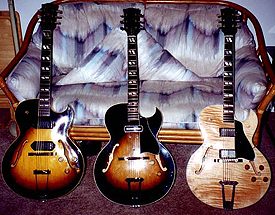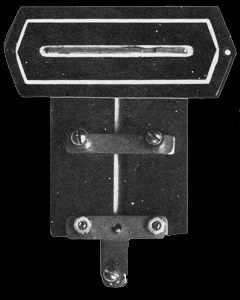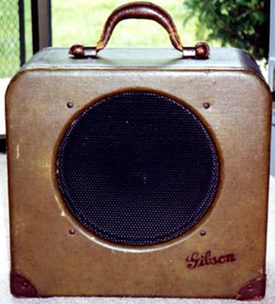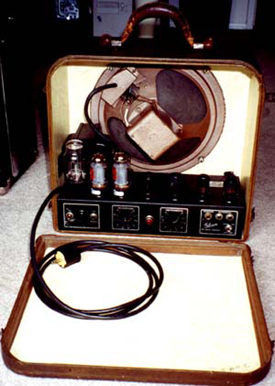Scroll through the lesson and click on notation/video/audio links to load the interactive players.
| Wolf Marshall >> Golden Age of Guitar Instrumentals >> |
|
|
Please subscribe to get full access to all lessons for only $7.95/month PLUS 1 week free trial.

Riff Interactive lessons are
LESS expensive and
MORE interactive than alternatives!
More Info
|
|

Wolf:
Charlie Christian was the first ELECTRIC guitarist in history. Charlie played bluesy swing jazz.
A lot of his early licks influenced blues and rock and roll..
novacane:
im into rock but i like to learn anything i can on the guitar
Wolf:
Nova, This will help your guitar vocab. When you play his licks you're into the real roots of blues and early rock.
From there you can build anything. He influenced ALL of the early electric guitarists.
tjd:
7 come 11
Wolf:
Seven Come Eleven has a classic CC riff, I'm gonna show you something unusual. The first electric guitar amp as used by CC.

Wolf:
Do you see the ES-175s in the pic everyone?
Tom:
The middle one has a CC pick-up
Wolf:
The middle one is called an ES-175CC because of the pickup. It has a sound just like his old ES-150.

John:
Is that a pickup?
Wolf:
The Christian bar pickup.

Wolf:
The amp you're seeing is the classic EH-150 from about 1938-41. It's the one you'll hear on all these licks.

Wolf:
The tubes aren't too hard to find--all 7 of them. It has a latching back that comes off. You'll see.
ginnym:
7 tubes , sounds warm
John:
I have an old GA-75 from my father in law. Look like it but his is a little bigger
Wolf:
The GA-75 is considerably bigger. Great tone too, here's a good piece of advice about old amps.
If you have one PLAY IT!! The filter caps dry out if you don't.
mudfish:
Wolf, I noticed the licks for the week were in d flat as is the jam. Is this a common key for Christian?
Wolf:
Mud, yes. when playing with horns it is common.
Dan:
why did Charlie die at such a young age?
Wolf:
Dan, Tuberculosis. He had a hard life and weak respiratory system
Wolf:
These are chord shapes to visualize while playing these licks, I included CC in great instrumentals because everything he played was instrumental and featured
electric guitar. Everyone from T-Bone to SRV used his licks--sometimes 3rd hand.
Here comes another CC lick:
Wolf:
This one has more extended harmonic sounds. Eb minor and Ab7 going to D flat.
Tom:
I think it is interesting that he mostly used down strokes,
Wolf:
CC did mostly use downstrokes
Tom:
and he hardly ever used his pinkey for fretting ,mostly a three finger player
Wolf:
Tom. That's right--like Wes and Benson.
mudfish:
It's a chromatic run and an arpeggio.
Wolf:
Mud. That's the vocab.
gnlplaer:
did he use a pic?
Wolf:
GNL, he used a large triangle pick. Notice that the chromatic run is based around the dominant 7th chord.
Lick 2 has a real rockabilly vibe. Bent double stops.
ginnym:
That is cool ! that I can feel naturally
Dan:
the tempo of the jam track seems really fast for me
Wolf:
Dan the swing tempos tended to be faster. You can learn the lick and lay it in with practice.
mudfish:
It seems real natural except for the B flat
Wolf:
Mud. Do you mean the A note. Chromatic passing tone? Or the one on the 4th string.
ginnym:
on the 4th string
mudfish:
8th fret - D string
Wolf:
You reach down with your index. It's a blues guitar fingering.
Tom:
that is classic Charlie
Wolf:
Like BB, Jimi and Albert Collins licks. What's unusual is the C to Db leading tone. It makes the lick!
ginnym:
that's what is cool about it
Wolf:
Exactly, gin, this next lick is a T-Bone blues phrase
Wolf:
The T-Bone and CC both had the same gear in my examples. For a reason . In the 1940s they both used similar equipment.
It's amazing how the two styles both had the same gear but such a different vibe and tone.
T-Bone used a hollow body with a CC pickup and a small Gibson amp too. What makes it sound so different is the vocabulary and attitude.
ginnym:
I would imagine that there was not a lot of different equipment to choose from so you would have to add a lot of your own personality
Wolf:
gin. That's why they had to work so hard in pioneering they new styles. Notice the bends and use of minor pentatonic scale.
All the blues guitarist began to copy T-Bone after the early 1940s. BB, Albert, you name
'em
ginnym:
I want to learn to make my guitar talk , moan and whine like they did
Wolf:
gin. that's in the vocal phrasing. Think of speech when you play these licks. Keep them in talking style phrases.
Buddy recorded T-Bone Shuffle on a famous album.
mudfish:
That lick seems very contemporary.
Wolf:
Mud. It's contemporary and immortal.
Wolf:
This T-Bone lick has the bends used as a riff--that's used a lot in modern blues and rock
ginnym:
I must have that somewhere ! or find it somewhere, which album
Wolf:
gin. The one with Junior Wells. t's called Buddy Guy and Jr. Wells Play the Blues. Atco.
These licks set the stage for the electric guitar to have its own voice. Next time we'll see what the next generation did with that.
It's been a pleasure to spend time with you. See you all next week. It'll be rockablilly and beyond.
|
<< load notation from left
|
|
<< load audio from left
|
<< load audio from left
|